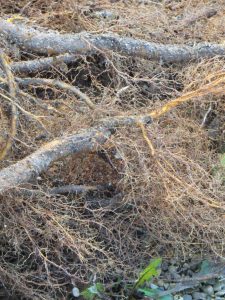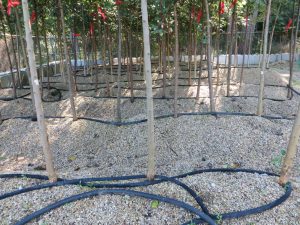 Gravel beds, a way of holding bare root trees and extending the bare root planting season, have been growing in popularity, especially in the Midwest. Several municipalities and other organizations throughout Wisconsin have been utilizing gravel beds to plant more trees on tight budgets, diversify plantings, decrease labor and ensure sound, healthy root systems. Hudson and Racine are wonderful examples of the success of gravel beds.
Gravel beds, a way of holding bare root trees and extending the bare root planting season, have been growing in popularity, especially in the Midwest. Several municipalities and other organizations throughout Wisconsin have been utilizing gravel beds to plant more trees on tight budgets, diversify plantings, decrease labor and ensure sound, healthy root systems. Hudson and Racine are wonderful examples of the success of gravel beds.
There are four main reasons for the cost benefit of using gravel beds: bare root stock are typically one fourth the price of balled and burlapped tree stock, transplanting bare root trees takes less people, it takes less time and it takes less equipment. The City of Racine uses five arborists to plant 50-60 trees a day, compared to 20-25 trees a day planting with balled and burlapped stock. The need of less equipment and muscle to plant trees opens the door for community volunteers to help get trees in the ground too.
When purchasing bare root trees, not only are the prices lower, but there are more species available. Higher species availability correlates with greater diversity in urban forestry, which leads to reduced vulnerability to pests and insect threats.
Gravel beds maintain moisture levels that allow for the dense development of fibrous root systems, which give them a leg up when planted in the urban environment. The extra mop of roots helps the tree take in more nutrients and water, thereby increasing the likelihood of successful, faster establishment.
 Quick establishment because of the extra fibrous root growth is a huge advantage; they are given a leg up over those not held in a gravel bed. Also, it extends the bare root planting season. Normally bare root trees are limited to a small planting window in spring, but with a gravel bed you can really plant them any time during the growing season because of the mop of fibrous roots. Hudson found success in using gravel beds over winter.
Quick establishment because of the extra fibrous root growth is a huge advantage; they are given a leg up over those not held in a gravel bed. Also, it extends the bare root planting season. Normally bare root trees are limited to a small planting window in spring, but with a gravel bed you can really plant them any time during the growing season because of the mop of fibrous roots. Hudson found success in using gravel beds over winter.
Gravel beds, in addition to other benefits, are relatively simple to develop. They consist of four components: a site, gravel, irrigation, trees. The site is dependent on what is available. Gravel beds can be built in a lumber enclosure, with concrete barriers, or without containment; with these options it is important to consider the budget and planned use of the gravel bed. The site requires good drainage and consistent access to water. Weather is a minor factor; if the site is in an area of high wind and sunlight the trees will need to be watered more often. It is better to find a site sheltered from the wind, to prevent uprooting, and slight shade.
Gravel type and irrigation are the next consideration. The gravel depth throughout the bed should be around 15 inches. The recommended gravel type is 3/8” washed river gravel; however, other gravels, or combination of gravel and sand, will work. The City of Racine uses a mixture of 90% pea-gravel and 10% fine grain sand.
 Irrigation for the gravel can be done many ways. Soaker hoses are the most common. They have easy installation and removal, low water usage, and less evaporation due to proximity to the gravel. Irrigation timers are important for consistent watering. Soaker hoses, drip tape and stationary spray heads are all options for irrigation. The standard timing for irrigation is 100 minutes a day separated out in four to six increments, with one increment during the night and another immediately before sun rise, but number and time of increments can vary.
Irrigation for the gravel can be done many ways. Soaker hoses are the most common. They have easy installation and removal, low water usage, and less evaporation due to proximity to the gravel. Irrigation timers are important for consistent watering. Soaker hoses, drip tape and stationary spray heads are all options for irrigation. The standard timing for irrigation is 100 minutes a day separated out in four to six increments, with one increment during the night and another immediately before sun rise, but number and time of increments can vary.
Irrigation, and the repeated watering of gravel beds, ensures moisture levels are adequate (moisture should still be felt four inches deep into the gravel at all times). Over irrigation can lead to poor drainage, which is the main drawback, and potential risk, with gravel beds. For this reason, it is important to have proper site choice, lay gravel properly and monitor irrigation to prevent drainage issues.
Trees are the most important part of all gravel beds. When the trees are being moved into or out of the gravel beds the root systems should be kept moist. This can be done with a water soaked canvas or burlap, or a soaker tub. Hudson and Racine uses a canvas sheet and hydrogel, a water-absorbing polymer that helps the root systems stay moist, when transferring trees. Bare root trees are easy to move into and out of gravel beds. However, all the same factors of tree selection should still apply: diversity, maintenance, size, where they will be planted. It is important to note that not all trees do well in a gravel bed.
Gravel beds are increasing in popularity and it isn’t hard to see why. Gravel beds help increase tree health, and stretch budget and planting times. There are several case studies of communities throughout Wisconsin that have successfully implemented this method. When ordering trees next season think: Are gravel beds right for my community? For more information on gravel beds talk to your Urban Forestry Regional Coordinator or view the Minnesota resources used for this article.
